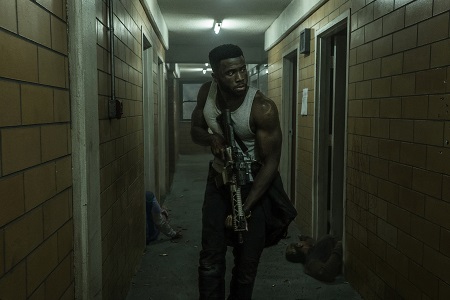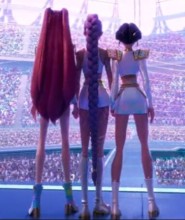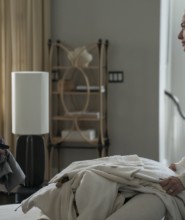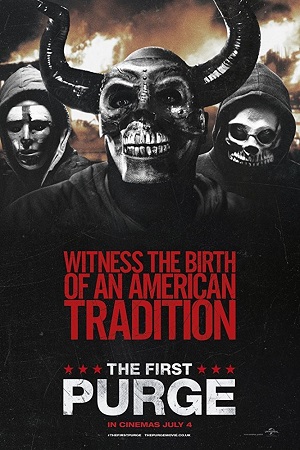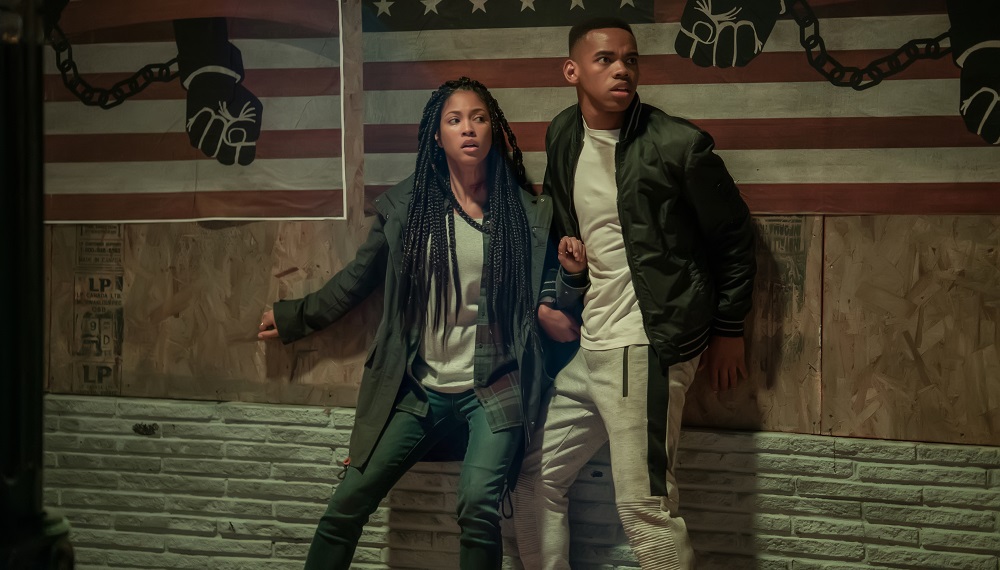
Violently Unsubtle Purge Prequel a Dystopian Nightmare
No one would accuse any of The Purge films of being subtle. Set in the not-so-distant future, this stripped-down dystopian horror effort presents an America where, for one night a year, all crime including murder is legal. The brainchild of writer/director James DeMonaco, each story showcases what might happen during this evening of debauchery and bloodshed. The 2013 initial entry focused on a suburban home invasion scenario with a wealthy Caucasian family forced to fight for this lives, while its 2014 follow-up The Purge: Anarchy opened up the concept and actually showcased what happens out on the streets of low-income minority neighborhoods. As for 2016’s The Purge: Election Year, DeMonaco took things to their logical conclusion showing just how involved government officials and conservative religious zealots, almost all of them White, male and very, very rich, were in ensuring that the poor, the disabled and anyone of minority descent were left all lifeless at the end of each and every Purge Night.
With the story pretty much reaching its climax during the last film, DeMonaco wraps things back to the beginning with The First Purge. Turning over the directorial reins to Gerard McMurray (Burning Sands), the story this time is set in an America that is much closer to the one we now live in. A rightwing wannabe oligarch has taken control of the Presidency by using a mixture of fear-mongering, race-baiting and craven subterfuge to convince U.S. citizens to elect him into office. Once in power, he and his minions, calling themselves the New Founding Fathers of America or the NFFA, come up with a plan to allow all crime to be legal overnight for one 12-hour period. Calling it “The Experiment,” this crazy idea will be tested on Staten Island, it’s low-income citizens offered a cool $5,000 if they remain in the city, more if they take part in the evening’s activities.
But this radical sociological theory, the brainchild of scientist Dr. Updale (Marisa Tomei), goes well beyond anything anyone could have imagined, especially after the government secretly sends in disguised agitators dressed in a variety of White Supremacist regalia to systematically kill everyone they encounter with extreme prejudice. It’s the template for what the NFFA hopes will become a national event, the seedlings for what will become Purge Night planted underneath the slums of the Staten Island apartment complexes where much of the slaughter will transpire.
It’s all is in-your-face and as exploitive as it sounds, DeMonaco not exactly hiding the fact this world he is imagining is very similar to the one we’re trying to live in right at this particular moment in history, it’s just one without out an evening of legalized rape, murder and all of the rest. But the fear-mongering? The rampant lies? The race-baiting and escalation of tensions between the few haves and the numerous have-nots? The politicization of health care, the rights of immigrants and social welfare programs designed to assist those in need? It’s all here sitting alongside the stylized ultra-violence and the plethora of obvious, if still admittedly effective, jump scares.
While these movies have never honestly risen to the potential of DeMonaco’s premise, that for some reason also hasn’t made them any less compelling or have diluted their ability to startle. It’s an odd franchise, one that hasn’t exactly gotten better as it has gone along but, at the same time, still manages to emotionally shock and satirically comment on real social and political problems in a way that is somewhat difficult turn one’s eyes away from. It’s a mixed bag, and it’s hard not to wonder what might have happened had these films sported a bit more intelligence and weren’t so didactically overt in their heavy-handed symbolism.
Even so, I’ve honestly found plenty to like about all of The Purge pictures, even this one. The majority of the actors here acquit themselves admirably, most notably Y’lan Noel as a local drug kingpin who quickly surmises The Experiment is just an excuse to eliminate Staten Island’s minority population and he and his crew are the last line of defense to make sure this doesn’t happen. Also quite good here is Lex Scott Davis as a longtime resident and activist who attempts to convince people to not take part in the evening’s events only to find herself forced to protect what matters most in her life using all means, including lethal ones, at her disposal to do so. While no one is going to win an Academy Award for their efforts the collective authenticity of the primary cast is never in doubt, and as such caring about whether they live or die is surprisingly easy to do.
I’m not sure what else there is to say. As far as The First Purge is concerned, Tomei’s appearance is more of a glorified cameo than it is anything else, and I can’t say the change from DeMonaco to McMurray in the director’s chair gives this prequel a narrative tone or a visual aesthetic all that far removed from its three predecessors. It’s all as bluntly heavy-handed as ever, this latest effort even going so far as to feature its very own villain who enjoys grabbing women by the you-know-where just so it can (rightfully) point out just how obscene and intolerable such behavior should be, even if perpetrators are almost never held accountable for doing so. If you liked the other installments in this franchise you owe it to yourself to give this prequel a look as it’s every bit as solid as they were. As for everyone else, why you’re even reading this review in the first place I honestly have no idea.
– Review reprinted courtesy of the SGN in Seattle
Film Rating: 2½ (out of 4)



